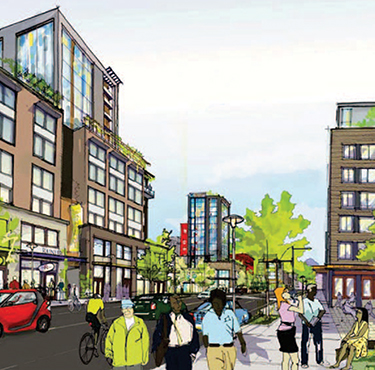|
Subscribe / Renew |
|
|
Contact Us |
|
| ► Subscribe to our Free Weekly Newsletter | |
| home | Welcome, sign in or click here to subscribe. | login |
Real Estate: Crib Notes by Joe Nabbefeld
| |

By Joe Nabbefeld |
March 26, 2015
Crib Notes: People, lots of them, are going to move here so don't let old planning models hold us back
Special to the Journal
Watching people in Seattle hyperbolize to fight zoning changes can be mind-altering. It's not political sport. More like demolition derby meets keystone cops.
We can only imagine what it must be like for some of the very good professional planners within the city.
Opponents scream that within days — or is it hours, or perhaps minutes — of a vote to increase zoning that, poof, new huge structures will rise on every lot. Behemoths will muscle in, destroying goodness, apple pie and my constitutional right to a free parking spot!
The reality: Rezoning neighborhoods normally triggers glacier-paced change. Eventually one new structure there, then a few years later, a second new structure here. And they bring improvements that wouldn't have happened without the zoning change.
Don't point to South Lake Union. South Lake Union is the exception, not the rule. South Lake Union is a once-in-a-lifetime phenomenon. Closest to ever come to SLU is China, which has had some of its own “Just add water and poof! A whole new town pops up.”
And please recall that South Lake Union was shooting up like dandelions on steroids long before any up-zoning, with Paul Allen's billions as the growth hormone. SLU was going great guns well before Amazon decided to juice it. Remember Fred Hutch? Leroy Hood? Biotech? UW?
Here's a better example of how zoning changes go: Molasses in winter. No wait: L-zoning. That's short for “lowrise.” These days it means where the townhomes are being built.
Notice that townhomes sprout in patches. There's a veritable Levittown of them northeast of 85th and Aurora, on the west slope of Madison Valley, the west slope of Queen Anne, the north slope above Fremont. These spots have L-zoning and it was put there — HERE'S THE KEY — decades ago (and received an upgrade about 5 years ago).
It might be cute, if it wasn't tragic, when folk go: “How did this happen? We've got to stop this NOW.” As if L-zoning slipped through the door last night during an episode of “Breaking Bad.”
Who even knows what the zoning is for the block their home is on? When the city entertains a zoning change proposal, they get the word out and get the word out and get the word out ... but still 10 or 15 years later people say: “Hey, how did this happen? When was this enacted?”
Hey, that's democracy, which is the only way to go. Corrections do occur that start from doom-gloom. Democracy can absorb these things. People need a voice. Bad urban planning decisions happen. Bad legislation gets passed. Misjudgments and mistakes happen, and some experiments go the wrong way.
Closing the apodments loophole is an example of a worthwhile correction.
But don't let the doom-glooms fool you. Cities constantly change and evolve, shaped by myriad currents: taste, growth, technology, environmental awareness, economics, employment, transportation, education, even global weather patterns.
Someday cars may be driving themselves. NPR had a piece the other day about how one day homes will have big lithium batteries, rechargeable by sunlight or who knows what, so all those power lines could go away.
Who'da thunk 10 years ago, even 5 years ago, that nearly everybody and his brother would want to live in an over-priced, shiny apartment in what was then the divinely gritty Pike-Pine Corridor? Or that someone would want to control a thermostat with a phone? Or hang out on the rooftop in the rain?
It happens.
Crib Notes falls in the new-eco camp on these things. Think of it as the “don't-sprawl” camp.
Studies show that city dwellers on average have 1/40th the carbon footprint of rural dwellers. One fortieth. The don't-sprawl camp also accepts what some others need to ignore: People, lots of them, are going to move here (and to other great cities). So don't let outdated planning models pushed by doom-glooms block getting these newcomers on the 1/40th-the-carbon diet.
They're comin'. Zoning changes will come too, with all the superannuated hyperbole.
Joe Nabbefeld is a Realtor with Windermere Capitol Hill. You can reach him at www.RealSolutions.biz. He was the DJC's commercial real estate editor back in the late 1990s and early 2000s.
Previous columns:
- Crib Notes: Keys are so last year! Let's get ready for homes we can run with our phones, 02-19-2015
- Crib Notes: Bettin' money says buy now in Pioneer Square, 01-22-2015
- Crib Notes: What's up for 2015? Bertha will be digging tunnels and homebuyers will be digging technology, 12-18-2014
- Crib Notes: Apartment developers today delivering easy commutes, fun Saturday mornings, 11-13-2014
- Crib Notes: Small housing units are here to stay, 10-16-2014
- Crib Notes: Even NAR gets it — Go green at home, 09-18-2014
- Crib Notes: Live-work units work, so bring ‘em on everywhere ‘creatives' are gathering, 08-14-2014
- Crib Notes: Relax everybody. It's just a boom, 07-24-2014



